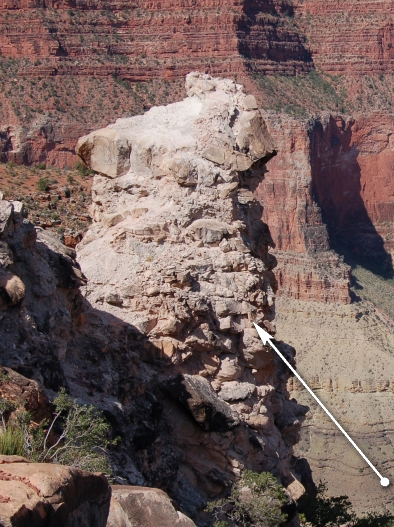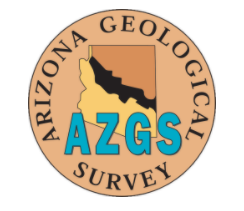As reported by the U.S. Energy Information Administration, Arizona energy consumption in 2015 was dominated by coal (~400 trillion BTU), natural gas (~375 trillion BTU), and nuclear electric power (~330 trillion BTU) fueled by uranium fission.
Renewable energy resources approached 100 trillion BTU, led by hydroelectric plants on the Colorado and Salt Rivers.
What the future holds. Arizona is well-positioned to build out renewable solar, wind, geothermal, and biofuel resources. Coal production from the Black Mesa strip mine will probably be reduced greatly following the closure of the Navajo Generating Station scheduled for 2019.
Oil & Natural Gas
Oil, natural gas, and coal are fossil fuels that form as a result of anaerobic decomposition of buried organisms. Fossil fuel deposits typically formed millions to tens or hundreds of millions of years before the present.
Arizona is not a major oil and gas producing state. Most production stems from small oil fields in northeastern Arizona. AZGS Circular 29, ‘Arizona has oil and gas potential‘, by Steve Rauzi (AZGS, retired) is an excellent starting point for learning about the states oil and gas resources.
Over the past 100 years, more than 1,100 oil and gas exploration wells have been drilled in Arizona. The locations and well logs – physical and electrical – of wells drilled since the 1920s are online at the interactive Arizona Oil and Gas Well Viewer. AZGS staff build the viewer before handing it off to the Arizona Dept. of Environmental Quality (ADEQ) in July 2016.
According to the Environmental Information Administration, “the largest producing oil field in Arizona—Dineh-bi-Keyah, The People’s Field—is on the Navajo reservation. Although production is now modest, the field has produced almost 19 million barrels of crude oil since its discovery in the mid-1960s.”
For information on oil and gas in Arizona, please visit the Arizona Oil and Gas Conservation Commission web page now maintained by the ADEQ.
Helium
While not an energy source, helium deposits in Arizona are often conflated with oil and gas deposits. Why? They share some of the same reservoir rock in northeastern Arizona. Also, the Arizona Oil & Gas Conservation Commission administers permitting for helium exploration and harvesting.
Economic helium deposits are situated in sedimentary basins of northeastern Arizona. From the 2003 report by AZGS’s Steve Rauzi, “Three (helium) fields were located in the Holbrook Basin south of the Defiance uplift about 35 miles northeast of Holbrook. One field was located in the Four Corners area north of the Defiance uplift near the small community of Teec Nos Pos. Helium-rich gas was discovered in the Dineh-bi-Keyah oil field on the northeastern flank of the Defiance uplift in the late 1960s but was not produced until 2003. Helium concentrations range from trace amounts up to 10% in the Holbrook Basin and Four Corners area. Both areas have good potential for additional discovery and production of helium.”
A world-wide shortage of helium in 2015 drove renewed helium exploration in northern Arizona. In 2017, helium production was underway in the Holbrook Basin. In July 2016, the Arizona state legislature transferred responsibility for permitting and monitoring helium production from the AZGS to the ADEQ. Those seeking information on helium exploration and production are directed to the Arizona Oil & Gas Conservation Commission administrator at the ADEQ (OGCC@azdeq.gov; 602-771-4501).
Uranium & Nuclear Energy
Public lands in the Southwestern U.S. have a checkered environmental history regarding uranium mining and milling. There remain scores of sorely contaminated mines and tailing sites, high cancer rates among miners and mining communities, and health hazards that linger and linger. According to an article by Brandon Loomis of the Arizona Republic (2014), the cost of cleaning up the hundreds of uranium mines on the Navajo Nation (Arizona, New Mexico, Utah) will top $3- to 4-billion.
In 1980, Robert Scarborough published a 5-page report, Uranium in Arizona, summarizing the boom times of Arizona’s uranium mining of the 1950s to 1969. According to that report, “18 million pounds of uranium concentrate have been produced from 328 mines in seven major areas in Arizona, mostly between 1948 and 1969.”
Arizona’s uranium production mostly involved Mesozoic sedimentary host rocks situated on the Colorado Plateau. The bulk of these deposits are on or adjacent to American Indian Tribal Lands in northern and northeastern Arizona.
The Chenoweth Collection. For nearly 50 years, geologist William Chenoweth ranged over the Southwestern U.S. examining and documenting uranium deposits and mines. Dr. Chenoweth began his uranium exploration career with the Atomic Energy Commission. To this day, he continues to publish results of his studies of the deposits, mineral production, and uranium miners of the Colorado Plateau.
Between 1985 and 2017, the AZGS published nearly 60 Chenoweth reports; his latest report was released in Jan. 2018. For those interested in reports on the geology and productivity of specific mines, the Chenoweth Collection makes an excellent starting point.
Northern Arizona’s Breccia Pipe Province. Some of America’s richest uranium deposits reside in breccia pipes on the Arizona Strip and adjacent to Grand Canyon National Park. From Spencer and others (2015), “The Grand Canyon region contains over 1300 known or suspected breccia pipes, which are vertical, pipe-shaped bodies of highly fractured rock that collapsed into voids created by dissolution of underlying rock. Some breccia pipes were mineralized with uranium oxide as well as sulfides of copper, zinc, silver, and other metals.”
On 1 Jan. 2012, Secretary of the Interior Salazar withdrew more than 1-million acres of federal lands in northern Arizona for new mining claims for a 20-year period. The moratorium did not invalidate existing claims or shutter previously existing mines.
This map shows the distribution of breccia pipes (#6 and 7) and sedimentary uranium deposits (#1, 2, 3, 4, 5, 8, 9 and 10). The photo on the right by Brian Gootee shows a breccia pipe column in Grand Canyon; note the broken nature (brecciation) of rock comprising the pipe.


Hydroelectric Energy
Arizona boasts 11 hydroelectric dams. The Colorado River’s Hoover and Glen Canyon Dams generate 3,400 MW of power annually; collectively this comprises ~ 88% of all electricity produced by Arizona’s hydroelectric dams.
The Bureau of Reclamation manages the Glen Canyon and Hoover Dams and the Western Area Power Administration bears the responsibility for distributing electricity. Long the chief renewable energy source in Arizona, distributed solar power plants are fast challenging hydroelectric for #1 among Arizona’s renewable energy sources.
The U.S. Energy Information Administration provides an overview of the role of renewable energy resources in Arizona.
Coal
From the profile analysis of the Environmental Information Agency: “There are two coal fields in Arizona—Black Mesa, in the northeast on the Navajo and Hopi reservations, and Pinedale in south-central Arizona. Those fields hold about 1% of the nation’s coal reserves at producing mines. The state’s only operating coal mine is in the Black Mesa field, and it is one of the 30 largest coal mines in the nation. Coal from that mine is sent by conveyor to a closed loop electric train that takes the crushed coal directly to the mine’s only customer, the coal-fired Navajo Generating Station, 80 miles away. However, the planned closure by 2019 of the Navajo Generating Station puts the mine’s continued operations at risk. Stakeholders in the mine are exploring options to keep the mine open, including new rail service to other areas. The coal that supplies Arizona’s other coal-fired power plants is brought into the state by rail, typically from New Mexico and Wyoming, with smaller amounts arriving from Montana and Colorado. Some coal from Colorado and Utah is also delivered to industrial plants in Arizona.“




